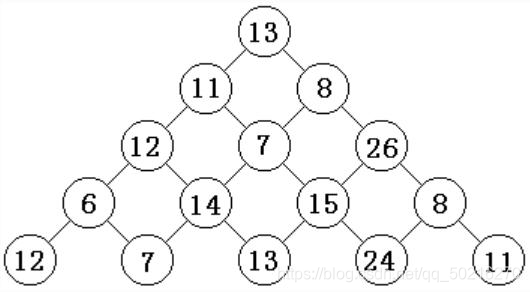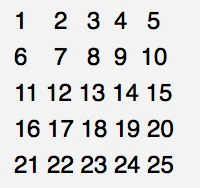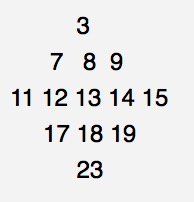数字三角形+字母塔+字母表+Matrix+ Jumping Frog(跳蛙)+求两圆相交的面积+看电影+谷歌的招聘+汉诺塔问题+表达式求值
7-1 数字三角形 (10分)
观察下面的数字金字塔。写一个程序查找从最高点到底部任意处结束的路径,使路径经过数字的和最大。每一步可以从当前点走到左下方的点也可以到达右下方的点。

在上面的样例中,从13到8到26到15到24的路径产生了最大的和86。
输入格式:
第一个行包含R(1≤ R≤1000),表示行的数目。
后面每行为这个数字金字塔特定行包含的整数。
所有的被供应的整数是非负的且不大于100。
输出格式:
单独的一行,包含那个可能得到的最大的和。
输入样例:
5
13
11 8
12 7 26
6 14 15 8
12 7 13 24 11
输出样例:
86
题解:
#include<iostream>
using namespace std;
int a[1001][1001];//存放数塔
int main()
{
int n;
cin>>n;
for(int i=1;i<=n;i++)
{
for(int j=1;j<=i;j++)cin>>a[i][j];
}
for(int i=n-1;i>=1;i--)
{
for(int j=1;j<=i;j++)
{
a[i][j]+=max(a[i+1][j],a[i+1][j+1]);//自底向上找最大值更新数塔
}
}
cout<<a[1][1];
return 0;
}
7-2 字母塔 (10分)
请编写程序,显示字母塔。
输入格式
高度(不超过 26 的正整数)
输出格式
显示指定高度的字母塔
输入样例
5
输出样例
A
ABA
ABCBA
ABCDCBA
ABCDEDCBA
题解:
//其实很简单,多试几次就好了
#include<iostream>
using namespace std;
int main()
{
int n;
cin>>n;
for(int i=1;i<=n;i++)
{
char x='A';
for(int j=n-i;j>0;j--)cout<<" ";
for(int j=1;j<=i;j++)
{
cout<<x;
x=x+1;
}
x=x-1;
for(int j=1;j<i;j++)
{
x=x-1;
cout<<x;
}
cout<<endl;
}
}
7-3 字母表 (10分)
我们定义一个小写字符串是“按字母表的”,当且仅当它删除掉一些字符后,可以变为”abcdefghijklmnopqrstuvwxyz”。 给定一个长度为n的小写字母字符串,至少插入多少个字符才能使其变成“按字母表的”。
输入格式:
输入第一行为一个整数T(1<=T<=100),代表测试数据的组数,随后T行,每行都是由小写字母’a’-'z’组成的一串字符s (1=<|n|<=50)。
输出格式:
输出为了让s变成“按字母表的”,至少要插入的字符个数,每组输出占一行。
输入样例:
2
xyzabcdefghijklmnopqrstuvw
aiemckgobjfndlhp
输出样例:
3
20
题解(军军):
//当作最长上升子序列
#include <bits/stdc++.h>
#define ll long long
using namespace std;
string q;
ll dp[105];
int main()
{
int t;
cin>>t;
while(t--)
{
cin>>q;
for (int i=0;i<105;i++)
{
dp[i] = 1;
}
for (int i=0; i <q.size(); i++)
{
for (int j=0;j<i;j++)
{
if (q[i]>q[j])
{
dp[i]=max(dp[i], dp[j]+1);
}
}
}
sort(dp,dp+105);
cout<<26-dp[104]<<endl;
}
return 0;
}
7-4 Matrix (10分)
Give you an N * N matrix, fill in the number of 1 to N * N in order, for example N = 5, the matrix is as follows

Now let you connect the midpoints of the adjacent two sides, and then only keep the numbers they enclose in the closed graphics area, then the matrix becomes

Now ask you for the sum of all the elements of the changed matrix.
输入格式:
Input the first line of an integer T (1 <= T <= 100) Next, there is a group test data, and each set of test data is input with an integer N (3 <= N <= 10000) Guaranteed input n is odd
输出格式:
For each set of test data, output the corresponding answer
输入样例:
在这里给出一组输入。例如:
2
3
5
输出样例:
在这里给出相应的输出。例如:
25
169
题解:
//找规律水题
#include<iostream>
using namespace std;
int main()
{
long long n;
cin>>n;
while(n--)
{
long long m;
cin>>m;
cout<<(1+m*m)/2*(1+m*m)/2<<endl;
}
}
7-5 Jumping Frog(跳蛙) (10分)
A frog is located at the coordinate (x1,y1). He wants to go to the coordinate (x2,y2). He will perform one or more jumps to reach his destination. The rule of the jumping is as follows:
青蛙位于坐标(x1,y1)处,他想转到坐标(x2,y2),他将进行一次或多次跳跃以到达目的地。跳跃规则如下:
Suppose the frog is located at the coordinate (x,y); then he can jump to the following foursquares:
假设青蛙位于坐标(x,y)处;然后他可以跳到以下四个方格:
(x+y,y)
(x-y,y)
(x,y+x)
(x,y-x)
The Problem: (存在的问题:)
Given the coordinates (x1,y1) and (x2,y2), you need to determine if it is possible for the frog to travel from (x1,y1) to (x2,y2) through a series of jumps as described.
给定坐标(x1,y1)和(x2,y2),您需要确定青蛙是否有可能通过一系列跳跃从(x1,y1)移动到(x2,y2)。
The Input:
The first input line contains an integer, n (1 ≤ n ≤ 100), indicating the number of test cases.
第一个输入行包含一个整数n(1≤n≤100),表示测试用例的数量。
Each test case consists of four integers (between -1,000,000,000 to +1,000,000,000 inclusive) separated by a single space denoting x1, y1, x2 and y2, respectively.
每个测试用例由四个整数(从-1,000,000,000到+1,000,000,000之间)组成,它们之间由一个单独的空格分隔,分别表示x1、y1、x2和y2。
The Output:
For each test case, output 1 if the frog can travel from (x1,y1) to (x2,y2) through a series of jumps as described or 0 otherwise.
对于每个测试用例,如果青蛙可以通过描述的一系列跳跃从(x1,y1)移动到(x2,y2),则输出1,否则输出0。
Sample Input:
3
-6 8 17 25
13 17 -16 11
0 0 5 6
Sample Output:
0
1
0
题解:
//由题意知他每次能移动的位移是其坐标的最大公因数的k倍,所以只要最大公因数相同即可
#include <bits/stdc++.h>
typedef long long ll;
using namespace std;
int gcd(ll a,ll b)
{
if(b==0)return a;
else return gcd(b,a%b);
}//gcd求最大公因数
int main()
{
ll n,x1,x2,y1,y2;
cin>>n;
while(n--)
{
cin>>x1>>y1>>x2>>y2;
if(gcd(abs(x1),abs(y1))==gcd(abs(x2),abs(y2)))cout<<1<<endl;
else cout<<0<<endl;
}
return 0;
}
7-6 求两圆相交的面积 (10分)
给定2圆的圆心坐标和半径,计算并输出两圆相交的面积,如果是外切或不相交,则输出0,圆周率取函数值acos(-1)。
输入格式:
输入6个整数x1 y1 r1 x2 y2 r2,分别表示两圆的圆心(x1,y1),(x2,y2)和半径r1,r2。
输出格式:
根据圆的位置关系,输出其相交部分的面积(保留2位小数)。
输入样例:
在这里给出2组输入。例如:
0 0 1 2 2 1
2 0 2 5 2 3
输出样例:
在这里给出相应的输出。例如:
0.00
3.22
题解:附一份手写推导(还在路上)
#include<iostream>
#include<math.h>
using namespace std;
int main()
{
int x1,y1,r1,x2,y2,r2;
cin>>x1>>y1>>r1>>x2>>y2>>r2;
double d=sqrt(pow((x1-x2),2)+pow((y1-y2),2));
if(d>=r1+r2)printf("%.2lf",0);//外切和相离
else if(d<=r1-r2)printf("%.2lf",acos(-1.0)*r2*r2);//两圆内切,r2小
else if(d<=r2-r1)printf("%.2lf",acos(-1.0)*r1*r1);//两圆内切,r1小
else//相交
{
double angle1=acos((r1*r1+d*d-r2*r2)/(2*r1*d));//左扇区对应角度
double angle2=acos((r2*r2+d*d-r1*r1)/(2*r2*d));//右扇区对应角度
double s1=angle1*r1*r1;//左扇区对应面积
double s2=angle2*r2*r2;//右扇区对应面积
double s3=r1*d*sin(angle1);//四边形面积
printf("%.2lf",s1+s2-s3);
}
}
7-7 看电影 (10分)
终于到周末了,明明是特别喜欢看电影。他想在一天内尽量多的看到完整的多部电影。 现在他把他喜欢的电影的播放时间表给你,希望你能帮他合理安排。
输入格式:
输入包含多组测试数据。每组输入的第一行是一个整数n(n<=100),表示明明喜欢的电影的总数。 接下来n行,每行输入两个整数si和ei(1<=i<=n),表示第i个电影的开始和结束时间,为了简化问题,每个时间都用一个正整数表示。 当n=0时,输入结束。
输出格式:
对于每组输入,输出能完整看到的电影的个数。
输入样例:
在这里给出一组输入。例如:
12
1 3
3 4
0 7
3 8
15 19
15 20
10 15
8 18
6 12
5 10
4 14
2 9
0
输出样例:
在这里给出相应的输出。例如:
5
题解(曹哥哥):
#include<iostream>
#include<algorithm>
using namespace std;
struct film
{
int a;
int b;
};
bool cmp(film x, film y)
{
return x.b < y. b;
}
int main()
{
int n;
while(cin>>n)
{
if(n==0)break;
int sum=0,i;
film f[101];
for(i=0;i<n;i++)cin>>f[i].a>>f[i].b;
sort(f,f+n,cmp);//对结束时间进行排序
int m=0;
for(i=0;i<n;i++)
{
if(f[i].a>=m)//从启示时间遍历
{
sum++;
m=f[i].b;
}
}
cout<<sum<<endl;
}
return 0;
}
7-8 谷歌的招聘 (10分)
2004 年 7 月,谷歌在硅谷的 101 号公路边竖立了一块巨大的广告牌(如下图)用于招聘。内容超级简单,就是一个以 .com 结尾的网址,而前面的网址是一个 10 位素数,这个素数是自然常数 e 中最早出现的 10 位连续数字。能找出这个素数的人,就可以通过访问谷歌的这个网站进入招聘流程的下一步。

自然常数 e 是一个著名的超越数,前面若干位写出来是这样的:e = 2.718281828459045235360287471352662497757247093699959574966967627724076630353547594571382178525166427427466391932003059921… 其中粗体标出的 10 位数就是答案。
本题要求你编程解决一个更通用的问题:从任一给定的长度为 L 的数字中,找出最早出现的 K 位连续数字所组成的素数。
输入格式:
输入在第一行给出 2 个正整数,分别是 L(不超过 1000 的正整数,为数字长度)和 K(小于 10 的正整数)。接下来一行给出一个长度为 L 的正整数 N。
输出格式:
在一行中输出 N 中最早出现的 K 位连续数字所组成的素数。如果这样的素数不存在,则输出 404。注意,原始数字中的前导零也计算在位数之内。例如在 200236 中找 4 位素数,0023 算是解;但第一位 2 不能被当成 0002 输出,因为在原始数字中不存在这个 2 的前导零。
输入样例 1:
20 5
23654987725541023819
输出样例 1:
49877
输入样例 2:
10 3
2468024680
输出样例 2:
404
题解:
#include<bits/stdc++.h>
using namespace std;
bool isprime(int n)
{
if (n<=1)//特判1不是质数
{
return false;
}
for(int i=2;i*i<=n;i++)
{
if(n%i==0)
{
return false;
}
}
return true;
}
int main()
{
int a,b,n;
cin>>a>>b;
string s,s2;
cin>>s;
for(int i=0;i<=a-b;i++)
{
s2=s.substr(i,b);//从下标为i开始截取长度为b位
n=stoi(s2);//string to int 字面意思
if(isprime(n))
{
cout<<s2<<endl;
return 0;
}
}
cout<<"404"<<endl;
return 0;
}
7-9 汉诺塔问题 (10分)
汉诺塔是一个源于印度古老传说的益智玩具。据说大梵天创造世界的时候做了三根金刚石柱子,在一根柱子上从下往上按照大小顺序摞着64片黄金圆盘,大梵天命令僧侣把圆盘移到另一根柱子上,并且规定:在小圆盘上不能放大圆盘,每次只能移动一个圆盘。当所有圆盘都移到另一根柱子上时,世界就会毁灭。
题图1.jpg
请编写程序,输入汉诺塔圆片的数量,输出移动汉诺塔的步骤。
输入格式
圆盘数 起始柱 目的柱 过度柱
输出格式
移动汉诺塔的步骤
每行显示一步操作,具体格式为:
盘片号: 起始柱 -> 目的柱
其中盘片号从 1 开始由小到大顺序编号。
输入样例
3
a c b
输出样例
1: a -> c
2: a -> b
1: c -> b
3: a -> c
1: b -> a
2: b -> c
1: a -> c
题解:
//运用整体思想,把最下面盘和上面所有盘看作两部分,循环递归
#include<iostream>
using namespace std;
void hano(int n,char x,char y,char z)//起始柱 目的柱 过度柱
{
if(n==1)printf("%d: %c -> %c\n",n,x,y);
else
{
hano(n-1,x,z,y);
printf("%d: %c -> %c\n",n,x,y);
hano(n-1,z,y,x);
}
}
int main(){
int n;
char x,y,z;
cin>>n>>x>>y>>z;
hano(n,x,y,z);
}
7-10 表达式求值 (10分)
机器人卡多掌握了加减法运算以后,最近由学会了一些简单的函数求值。比如,它知道函数min(20, 23)的值是20, add(10, 98)的值是108等等。经过训练,机器人卡多甚至会计算一种嵌套的更复杂的表达式。
假设表达式可以简单定义为: 1、 一个正的十进制数x是一个表达式。 2、 如果x和y是表达式,则函数min(x, y)也是表达式,其值为x,y中的最小数。 3、 如果x和y是表达式,则函数max(x, y)也是表达式,其值为x,y中的最大数。 4、 如果x和y是表达式,则函数add(x,y)也是表达式,其值为x,y之和。 5、 如果x和y是表达式,则函数sub(x,y)也是表达式,其值为x,y之差。 例如,表达式 max(add(1,2),7)的值为7。
请你编写程序,对于给定的一组表达式,帮助Dr.Kong算出正确答案,以便校对卡多计算的正误。
输入格式:
第一行:N表示要计算的表达式个数(1≤N≤10) 接下来有N行,每行是一个字符串,表示待求值的表达式。 (表达式中不会有多余的空格,每行不超过300个字符,表达式中出现的十进制数都不超过1000)。
输出格式:
输出有N行,每一行对应一个表达式的值。
输入样例:
在这里给出一组输入。例如:
3
add(1,2)
sub(1,999)
add(min(1,1000),add(100,99))
输出样例:
在这里给出相应的输出。例如:
3
-998
200
题解(闫神):
#include <iostream>
#include <stack>
#include <cstring>
using namespace std;
const int N = 103100;
stack <int> op;
// 存储add, max, min, sub 这些运算符
// add = -1, sub = -2, min = -3 , max = -4
stack <int> number;
// 存储整数
char a[N];
int main()
{
int T;
cin >> T;
for(int t=1; t<=T; t++) {
memset(a,0,sizeof(a));
cin >> a;
int len =strlen(a); // len 字符串a 的长度
for(int i=0; i<len; i++) {
if(a[i] == ')') // 找到 ')' 前面为目前的最小项
{
// 把最小项转换成数值入栈
int optemp = op.top();
op.pop();
int x = number.top();
number.pop();
int y = number.top();
number.pop();
if(optemp == -1) number.push(x+y);
else if(optemp == -2) number.push(y-x);
else if(optemp == -3) number.push(min(x,y));
else if(optemp == -4) number.push(max(x,y));
}
else if(a[i] == 'a' && a[i+1] == 'd') // 找到add, op 入栈 -1
op.push( -1 );
else if(a[i] == 's' && a[i+1] == 'u') // 找到sub, op 入栈 -2
op.push( -2 );
else if(a[i] == 'm' && a[i+1] == 'i') // 找到min, op 入栈 -3
op.push( -3 );
else if(a[i] == 'm' && a[i+1] == 'a')
op.push( -4 );
else if(isdigit(a[i])) {
// 找到数字,求他的值,入栈到 number
int temp = 0;
while(isdigit(a[i])) {
temp = temp*10 + a[i]-'0';
i++;
}
i--;
number.push(temp);
}
}
cout << number.top() << endl;
number.pop();
}
return 0;
}
来源:oschina
链接:https://my.oschina.net/u/4340533/blog/4888179